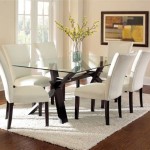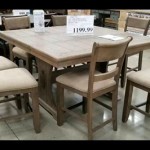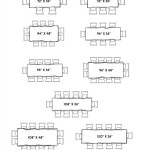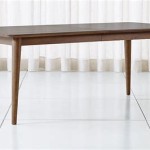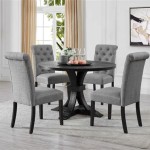How Wide Are Dining Room Tables? Understanding Dimensions for Comfortable Dining
The dining room table serves as a central piece in many homes, facilitating not only meals but also social gatherings, game nights, and even work from home activities. One crucial aspect of selecting a dining table is its width, as this dimension directly impacts the comfort and functionality of the table for daily use and special occasions. Understanding the standard widths available, the factors influencing width selection, and the implications of different widths on dining space planning is essential for making an informed decision.
The width of a dining room table dictates how much food, décor, and serving dishes can be comfortably placed on the table. It also affects how easily diners can reach food located further from the edge of the table and the overall feeling of spaciousness or crowding. Therefore, carefully considering the width based on individual needs and spatial limitations is paramount for creating a pleasant and functional dining experience.
Standard Dining Table Widths
While custom dining tables can be made to virtually any width, several standard widths are commonly available from furniture manufacturers. These standard dimensions are generally based on accommodating the typical place settings and serving arrangements for a particular number of diners. Recognizing these standard widths provides a useful starting point for selecting the appropriate table for a given dining space and family size.
For smaller dining areas or those primarily serving two to four people, a table width of 36 inches is frequently chosen. This width provides ample space for individual place settings and a central serving dish or two. It is suitable for more intimate dining experiences and can be easily incorporated into smaller apartments or breakfast nooks.
A mid-size dining table, generally accommodating four to six diners, typically measures between 40 and 44 inches wide. This width allows for more elaborate meal arrangements, including multiple serving platters or decorative centerpieces. This is a versatile size that suits a range of dining rooms and family sizes, providing a balance between space efficiency and ample surface area.
Larger dining tables, designed to seat six or more people, are typically 48 inches wide or greater. A width of 48 inches provides a substantial amount of space for large family dinners, holiday gatherings, or entertaining guests. Some tables may even extend to 54 inches or 60 inches wide to accommodate even larger parties or incorporate built-in features like leaf extensions. These wider tables can create a more formal and luxurious dining atmosphere, but require a larger dining area to ensure comfortable circulation around the table.
It is important to note that these are general guidelines, and some variations may occur based on the specific design or style of the table. For instance, a narrower rectangular table might be longer than a wider round table designed to seat the same number of people. Always confirm the exact dimensions of the table before making a purchase to ensure it meets your specific needs and fits comfortably within your designated dining space.
Factors Influencing Dining Table Width Selection
Selecting the appropriate dining table width involves careful consideration of several interrelated factors. These factors encompass the size and configuration of the dining room, the number of people typically dining at the table, the frequency of entertaining, and the desired aesthetic of the dining space. Each of these factors plays a significant role in determining the optimal width for a particular situation.
The size and shape of the dining room are arguably the most crucial considerations. A large dining room can comfortably accommodate a wider table without feeling cramped, while a smaller dining room may require a narrower table to maintain adequate space for circulation and other furniture. It is imperative to measure the dining area accurately and consider the placement of other furniture, such as sideboards, buffets, or china cabinets, when determining the maximum width of the dining table. A general rule of thumb is to leave at least 36 inches of space between the edge of the table and any walls or furniture to allow for comfortable movement around the table. For wheelchair accessibility, 48 inches of space is recommended.
The number of people who will typically be dining at the table is another key factor. If the table is primarily used by a small family of two or three, a narrower table may suffice. However, if the table is frequently used for larger gatherings or entertaining guests, a wider table will be necessary to provide adequate space for all diners and their individual place settings. Consider the maximum number of people you anticipate seating at the table and factor in additional space for serving dishes and decorative elements.
The frequency of entertaining also influences the ideal table width. If the dining table is primarily used for everyday meals, a moderate width may be sufficient. However, if the table is frequently used for hosting dinner parties or holiday celebrations, a wider table is often preferred to accommodate larger spreads and more elaborate table settings. Think about the types of meals you typically serve and the amount of space you will need for serving dishes, platters, and beverages.
Finally, the overall aesthetic of the dining space can also play a role in determining the appropriate table width. A wider table can create a more formal and luxurious dining atmosphere, while a narrower table may be more appropriate for a casual or minimalist setting. Consider the style of your home and the overall design vision for your dining room when selecting a table width. A wide table can serve as a statement piece, while a narrower table can blend seamlessly into the existing decor.
Implications of Dining Table Width on Space Planning
The width of a dining table profoundly affects the overall layout and functionality of a dining space. Careful consideration of the table's width is essential for creating a comfortable and visually appealing dining environment. The impact of width choices can influence traffic flow, visual balance, and the sense of spaciousness within the room.
A wider table can create a more formal and grand dining experience, but it also requires more space. In a smaller dining room, a wide table can make the room feel cramped and restrict movement. Conversely, a narrower table in a large dining room may feel disproportionately small and create a sense of emptiness. It is important to strike a balance between the size of the table and the size of the room to create a harmonious and functional space.
The width of the table also affects the traffic flow around the table. A table that is too wide can obstruct pathways and make it difficult to move around the room. Ensure that there is sufficient space between the table and any walls or furniture to allow for comfortable circulation, even when diners are seated at the table. Consider how people will enter and exit the dining room and plan the layout accordingly.
Visual balance is another important aspect to consider when selecting a dining table width. A wide table can visually anchor the room and create a sense of stability, while a narrower table may feel less grounded. Consider the other elements in the room, such as artwork, lighting, and furniture, and choose a table width that complements the overall design. A wider table may require larger, more substantial chairs to maintain visual balance, while a narrower table may be paired with more delicate or lightweight chairs.
The perceived spaciousness of the dining room is also directly impacted by the table width. A narrower table can create a sense of openness and airiness, while a wider table can make the room feel more enclosed. If maximizing the sense of space is a priority, opt for a narrower table and consider using lighter colors and reflective surfaces to enhance the feeling of spaciousness. Alternatively, if you prefer a more intimate and cozy dining environment, a wider table may be a suitable choice.
Ultimately, selecting the right dining table width is a complex decision that requires careful consideration of multiple factors. By understanding the standard widths available, the factors influencing width selection, and the implications of different widths on space planning, individuals can make an informed decision that creates a comfortable, functional, and aesthetically pleasing dining experience.

A Guide To Choosing The Ideal Dining Table Width

How To Choose The Right Dining Table Size And Shape Contemporary Wooden Furniture Hand Made In Cincinnati Ohio Modern Traditional Craft

A Guide To Choosing The Ideal Dining Table Width

A Guide To Choosing The Ideal Dining Table Width

8 Seat Dining Table At Kalyanam Furniture

Extra Large And Long Mahogany Dining Table With Two 36 Leaves Four 18 10 22 Feet High End

Dining Table Sets Upto 70 Off In India Royaloak
Newport 9 Piece Dining Table Set Costco

Brown 6 Seater Wooden Dining Table Set For Home Size 5 Feet Length 3 Width At 18600 In Ernakulam

8 Seat Dining Table At Kalyanam Furniture


